
[All Japan Robot Sumo Tournament Official Regulation]
All Japan Robot-Sumo Tournament Secretariat
Official Document
Version 4.3 – English
Fujisoft Incorporated
B
Battle: is the confrontation between 2 robots and is composed of 3 matches mainly.
C
Crystal: is a piezoelectric device used to determine the frequency range and channels in traditional Radio Control Systems.
D
Dohyo: is the match ring where the robots fight.
Dohyo Jonai: is all the match area considered as battle zone.
Dohyo Jogai: is all the outside area from the Dohyo Jonai.
F
Fusensho: a win by default or without fighting due to the opponent not appearing, normally because of injury or when the opponent robot doesn´t works before the battle.
H
Hakama: is a truncated rectangular pyramid which serves as base of the Dohyo.
Hansoku: means literally violation or penalty.
Hansoku-Make: means literally losing a battle by violation or penalty.
J
Judge Remote Control: Is the official remote control used only by the judges to start/stop movement of an autonomous type robot.
K
Keikoku: means literally warning or advise.
M
Match: is the length time where 2 robots fight with the goal of pushing the opponent outside the Dohyo.
P
PCS: Proportional Control System, is the radio control system used in the RC type, is composed by one transmitter and one receiver.
S
Shikiri-sen: means literally starting line, delimits where does the robot can be placed inside the Dohyo.
Shikkaku: means literally disqualification.
Shinitai: means literally death robot, is referred to a robot that cannot move because it wheels doesn´t touch the Dohyo.
SPCC: cold-reduced carbon steel.
T
Tawara: means dividing line or white line, delimits the external border of the Dohyo.
Torinaoshi: means literally rematch or to repeat a match because is determined by the judges.
Y
Yuko point: means effective point and is deemed to the robot that defeats the opponent during a match.
Yusei: means literally predominant robot, is referred to the robot that showed more battle actions.
Yochi: is the square area where the Dohyo is placed and delimits the safe area.
[Objective]
Article 1.
This regulation defines the rules of a battle and regulations for the All Japan Robot-Sumo Tournament.
[Definition]
Article 2.
In a match, both contestants (for every unit of robot, a single operator shall be registered and a single assistant can be attached; provided, however, that the assistant cannot concurrently serve as an operator) will play the match and compete for a Yuko Point using each own made Radio-Control type or Autonomous type robot in a Dohyo as pre-allocated in accordance with this Official Regulation (hereinafter referred to as “this Regulation”), and a judge will determine the winner.
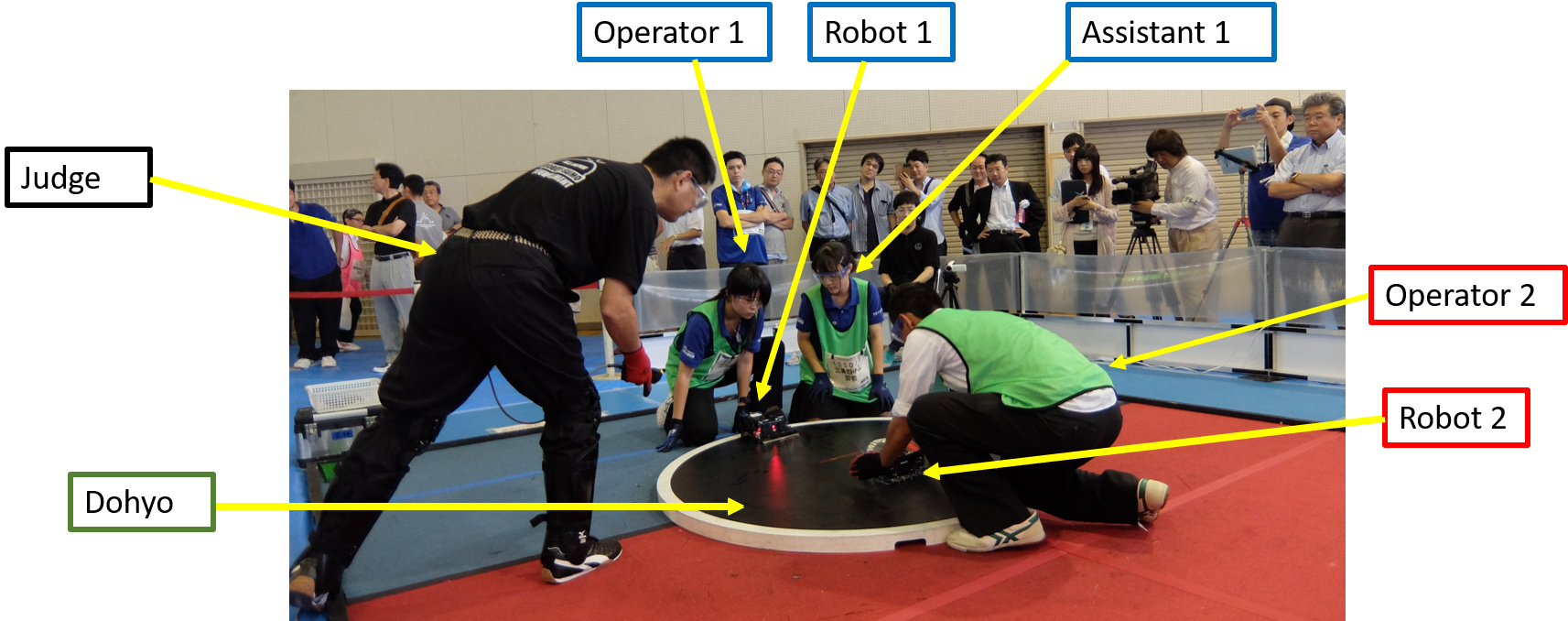
[Dohyo Specifications]
Article 3.
Dohyo specifications shall be as follows:
1. Definition of Dohyo Jonai
(1) A Dohyo Jonai consists of a Dohyo and a Yochi. The rest of the space is referred to as a Dohyo Jogai.
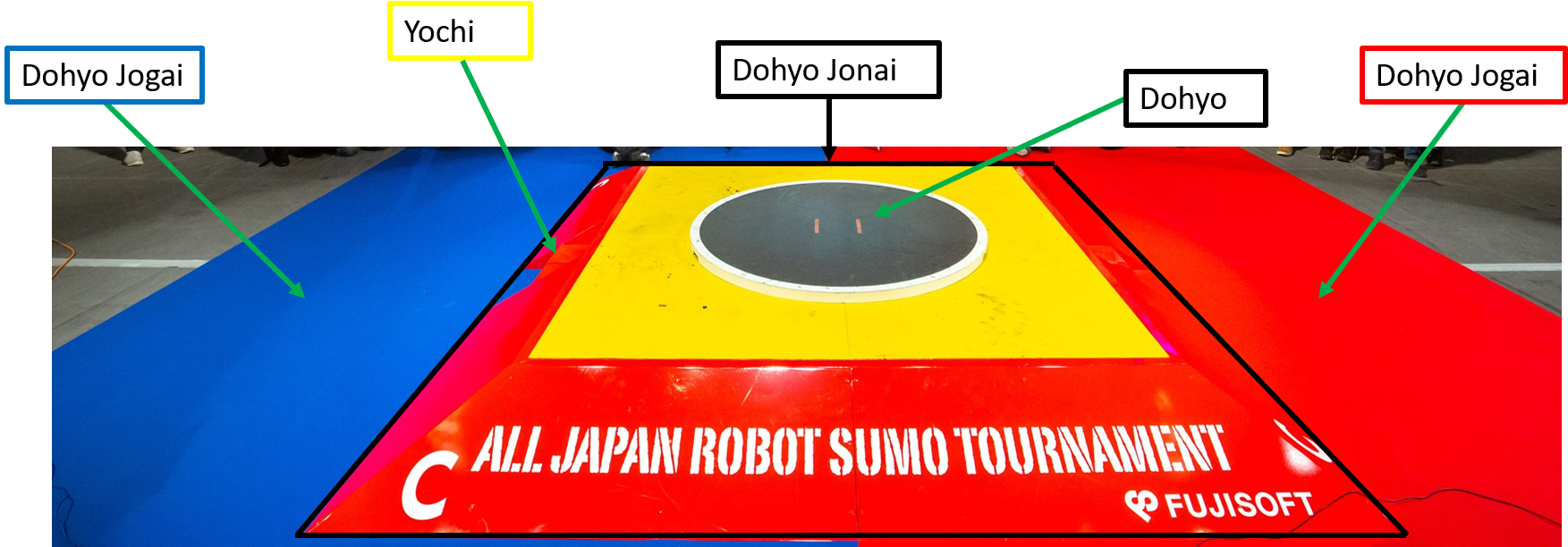
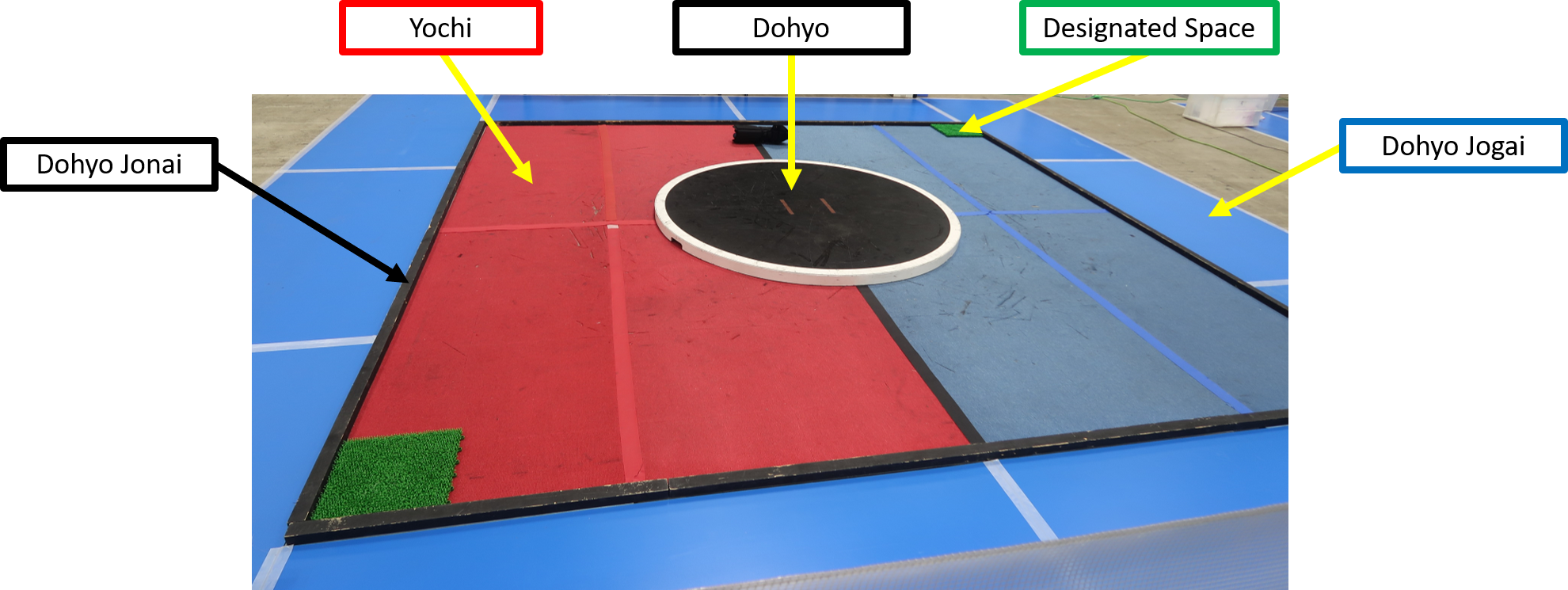
2. Specifications of Dohyo
(1) Dohyo shall be a circular aluminum frame of 154 cm diameter (including Tawara) which is covered by a black SPCC sheet located on the top at 5 cm of height.
3. Shikiri-Sen
Shikiri-Sen shall be indicated as two brown lines with a width of 2 cm and a length of 20 cm. Each line shall be located at 10 cm right and left from the center of the Dohyo.
4. Tawara
(1) Tawara shall be indicated by a white circle line of 5 cm width, from the inside to the outer line of Dohyo (The Tawara shall be considered as within of the Dohyo).
5. Yochi
Yochi shall be a square area whose side is 360 cm. The shape and material are free, but attention must be paid to safety.
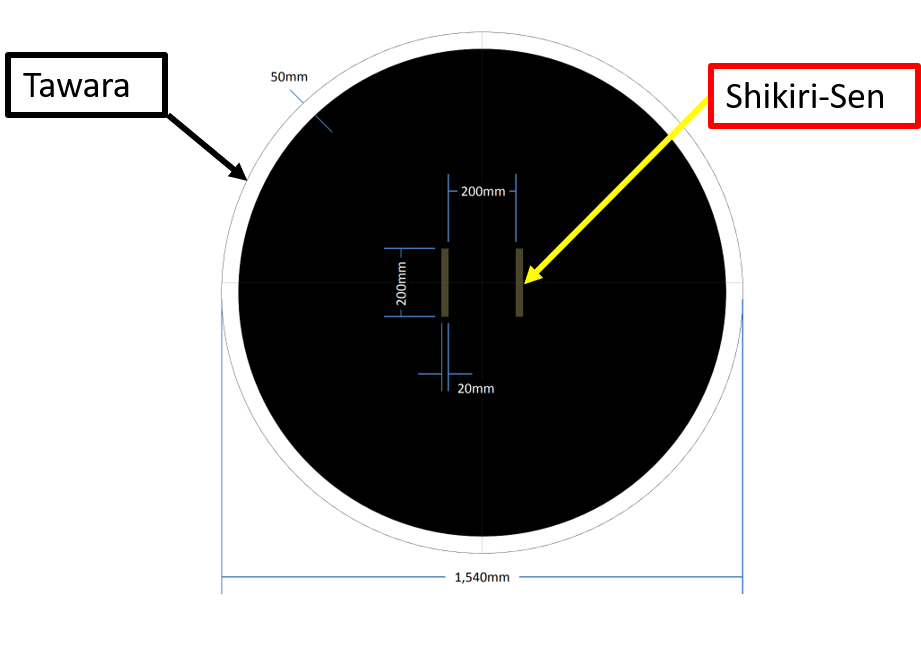
[Robot Specifications]
Article 4.
Robot specifications shall be as follows:
1. Robot Measures:
(1) A robot shall measure less than or equal to 20 cm width and 20 cm depth (no height restrictions) and able to fit in a cubicle box frame for standard inspection.
2. Robot Weight:
(1) A robot shall weight less than or equal to 3,000 g (including accessories); provided, however, in the case of the radio-control type robots the weight of the PCS shall be excluded from the 3,000g limit.
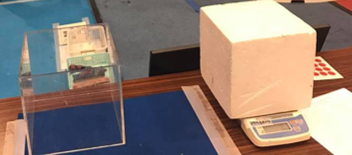
3. Usable radio waves for radio-control type robots shall be narrow band waves of 2.4 GHz, 27 MHz (01-12) or 40 MHz (61, 63, 65, 67, 69, 71, 73, 75 band).
4. Requirement of PCS
(1) Only one PCS shall be allowed for each robot.
(2) For PCS, only the Fujisoft Shin Rajikon System or those Radio Control Systems made by Futaba, JR, Sanwa, Kondo Kagaku can be used. (Any other brand can be considered if it fulfills the radio waves rules).
5. Crystal
(1) Contestants shall bring and use such crystal reception parts for the radio-control type robots as the wave ranges usable in the tournament, with a prior approval of the administration office. If the crystal brought by him contains any deficiencies, contestants shall use those provided by the administration office.
(2) Contestants shall preliminary take measures, so the crystal reception parts can be easily fixed to and removed from the robot.
(3) This shall not apply to the cases where the contestant uses the Fujisoft Shin Rajikon System or the other brands of Radio Control Systems.
6. Autonomous type robot - Starting movement
(1) The robot must start instruction from the Judge Remote Control signal by "start /stop ". The operation of the Judge Remote Control is performed by the judgment or the event staff from Dohyo Jogai.
7. Autonomous type robot - Stopping movement
(1) An Autonomous type robot must be stopped by a Judge Remote Control or a player's remote control signal. The operation of the Judge Remote Control is performed by the judgment or the battle staff from Dohyo Jogai.
(2) If the "Remote Control" is based on radio waves, the wave range for the radio-control robot type used in the tournament is not allowed; provided, however, 2.4GHz is excluded. Also, you should not use PCS or other than the new Remote Control System.

8. Conditions for usage of blades
(1) It is totally prohibited the usage of materials that can be broken in two parts while operating the robot or when the robots come into contact.
9. Measures of fire prevention
(1) To prevent over-current to the battery, safety equipment as fuse, poly-switch and built-in blocking within the circuit, shall be taken.

[Movement conditions for Autonomous type robot]
Article 5.
A robot shall be designed to detect, turn, face and act showing its fight against the opponent by itself. In the case of doubt in its movement, any operation check may be made under the instructions of the judges. (The operation check shall be carried out under the conditions the match has terminated, without any program change and before determining if it applies Hansoku-Make or not.)
[Conditions of "Remote Control" usage for Autonomous type robot]
Article 6.
1. Contestants shall put at the designated place and shall not touch the "Remote Control" until receiving instructions from judges.

2. Operation of the "Remote Control" to stop the movement of the robot shall be performed from Dohyo Jogai.
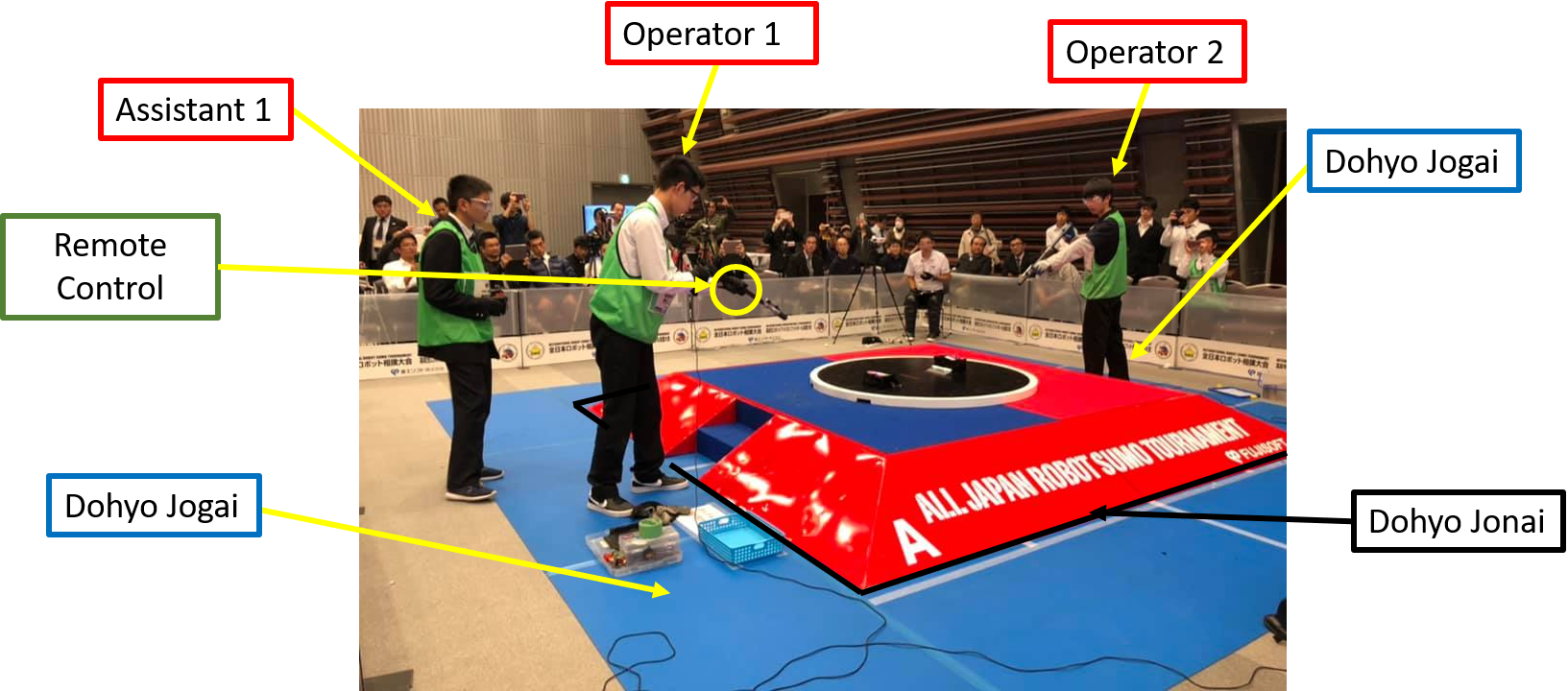
[Prohibited matters in designing and making robots]
Article 7.
1. Robots may not contain any disturbing wave generators or any components which may disturb the control of the opponent’s robot, such as laser, flash or infrared light.
2. Any components which may scratch or cause any damage on the surface of Dohyo shall be prohibited.
3. Robots may not contain any devices which spray any charged liquid, powder or gas to the opponent.
4. Robots may not contain any ignition devices.
5. Robots may not contain any shooting or throwing devices.
6. Robots may not contain any parts which fix the robot to Dohyo surface and prevent it from moving, such as suckers, glue and so on.
[Battle Rules]
Article 8.
1. As a basic rule, battle time shall be based on three matches within three minutes, and the team which gets two Yuko points during the battle time will be deemed the winner.
2. If only one Yuko Point has been won by the end of the battle time, the team which has won the Yuko Point will be deemed the winner.
3. If neither of the teams wins the match within the battle time, the winner will be decided according to Article 15 [Yusei].
1)If the head judge cannot determine a winner through the Article 15 [Yusei], the battle time will be extended by three minutes. In the extension time, the team which gets one Yuko Point will be deemed the winner of the battle.
4. No maintenance is allowed until the battle is over; provided, however, that this shall not apply to any maintenance carried out during waiting time for the next battle or any programming, code or routine change for Autonomous type robot carried out during the battle.
[Safety Measures]
Article 9.
1. To guarantee safety, contestants and judges shall wear goggle, gloves and sports shoes during the battle.
2. For radio-control type robots, PCS shall be placed at designated place, operated as per “start/stop” signals indicated by Judges and may not be operated outside the match time. Therefore, for placing a robot into Shikiri-Sen using PCS shall be prohibited. Contestants shall promptly have the robot positioned at the Shikiri-Sen manually and have it ready for the match.
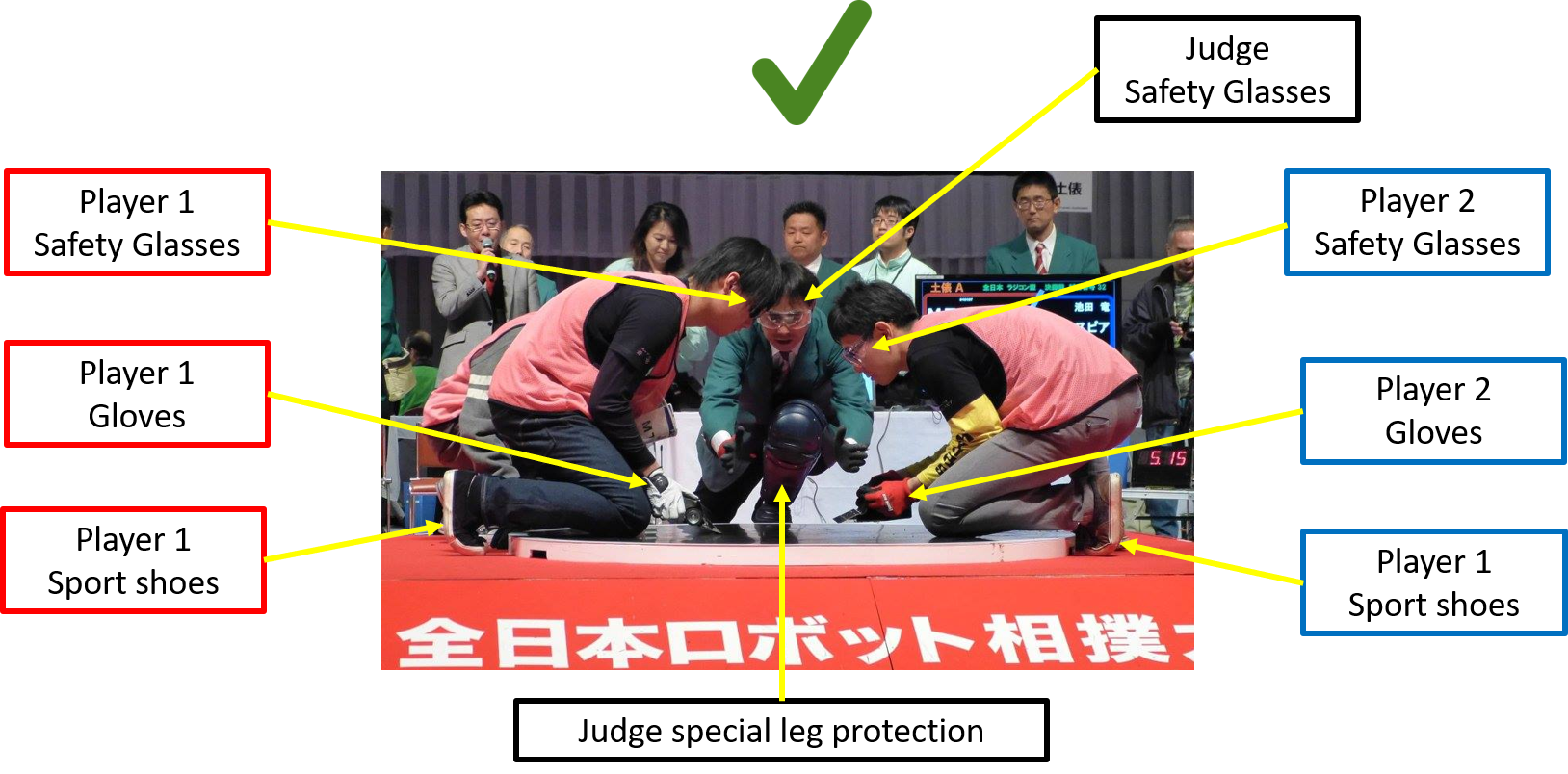
[Match Beginning]
Article 10.
1. A match will begin following the instruction of the judges. Contestants will bow to each other at the Dohyo Jogai and then enter to the Dohyo Jonai. Before the beginning of the battle and restart of a match, all the settings of the robot must be done promptly inside of Dohyo Jonai.
2. When the judge indicates it, the robots must be placed in the Dohyo at the same time as the opponent. No robot must exceed the Shikiri-Sen and must be placed inside the imaginary extension drawn from both ends of the Shikiri-Sen to the Tawara. Even if the robot is not completely inside the imaginary extension, the placement will be correct if any part of the robot touches the extension.
**After having placed the robot in the Dohyo you must leave the Dohyo Jonai immediately.
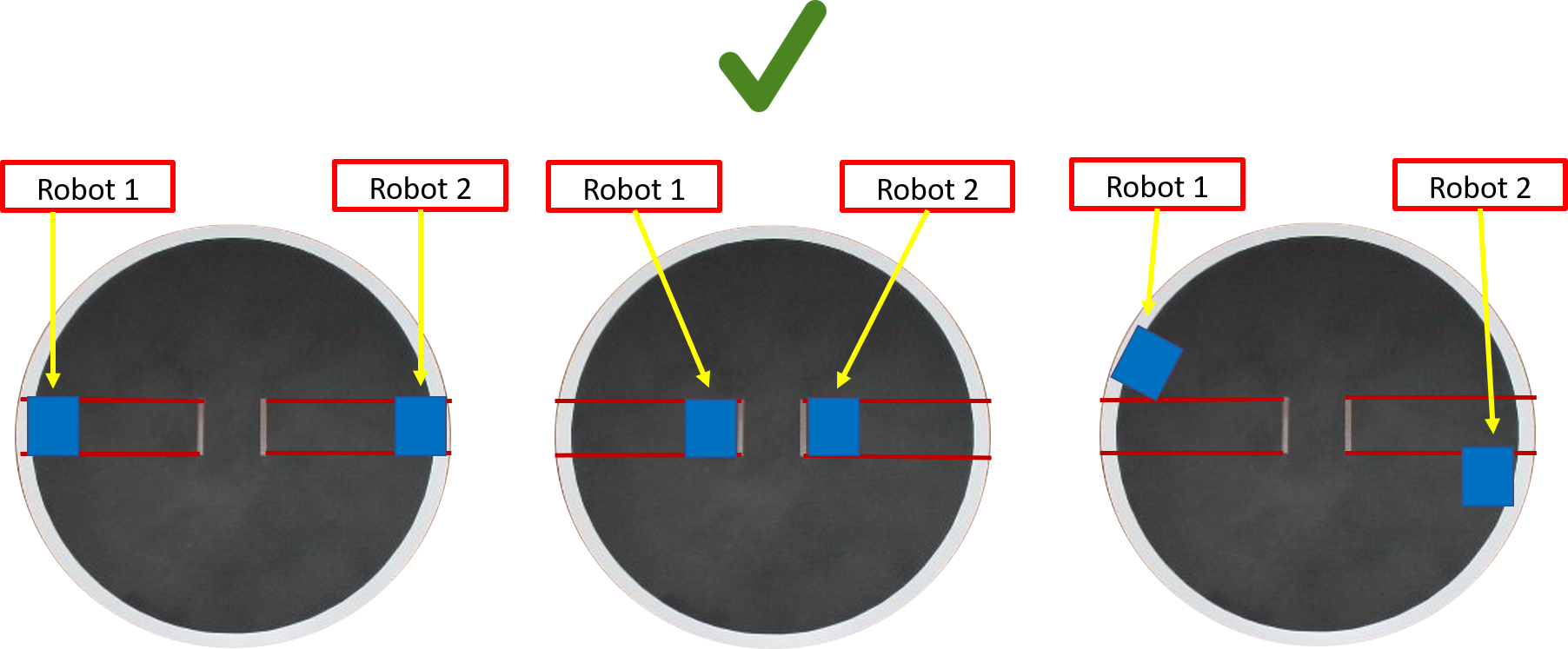

3. Radio control type robots starts the match with an electronic sound.
4. Autonomous type robots starts the match with the instruction of the Judge Remote Control operated by a judge or event staff.
5. Regarding scratches and dirt of Dohyo, if the judge decides that the match is possible, it will continue the game without exchanging the Dohyo.
[Match Ending]
Article 11.
1. Robots must stop immediately at the signal or instruction of the judges. The Autonomous type must stop immediately through the Judge Remote Control operated by the judge. (If necessary, participants can use their remote control to stop their robot from the Dohyo Jogai).
2. Battle shall be officially end by announcement of the winner made by the main judge. Players should bow to each other.
[Torinaoshi]
Article 12.
If any of the following situations arises, the match shall be suspended, and rematch shall be carried out:
1. Both robots are in state of contact with each other, and either become unable to move or are running on the same orbit; even after the judge counts until 3 and the situation doesn´t changes.
2. Both robots touch simultaneously or at the same time any part outside the Dohyo.
3. The judges decide that it is impossible to determine the winner.
4. If winner cannot be determined after the Torinaoshi, the main judge can allocate the position of the robots and resume the match. In the case where the game does not arrive further, judges can decide "superiors" decisions.
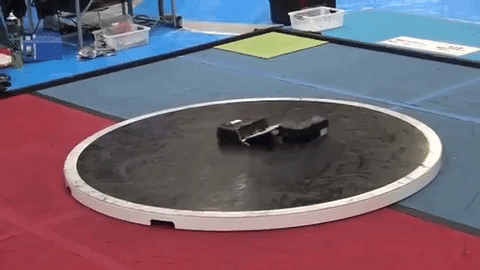
[Yuko Point]
Article 13.
If any of the following situations arises, the contestant shall get a Yuko Point:
1. Its robot makes the opponent’s robot touch any part outside the Dohyo legally.
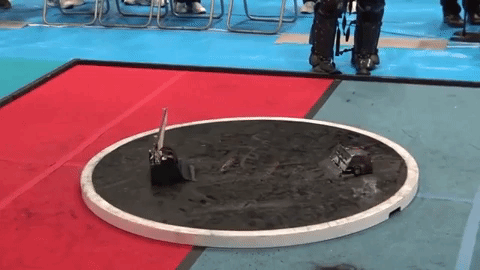
2. The opponent's robot touches any part outside the Dohyo for any reason.
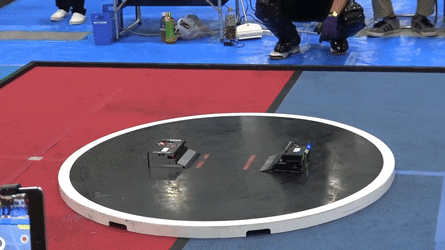
3. The opponent's robot is judged as the "Shinitai" pursuant to Article 14.
4. Its robot is judged as the "Yusei " pursuant to Article 15.
5. "Keikoku" as defined in Article 16 is given twice to the opponent.
6. The opponent is judged as having committed "Hansoku" as defined in Article 17.
7. A winner who has been granted Fusensho as defined in Article 20 paragraph 3, shall be granted two Yuko points; provided that if he/she has already had one Yuko Point then one Yuko Point shall be granted. The number of Yuko Points having been acquired by the opponent who lost the match shall remain effective.
[Shinitai]
Article 14.
One Yuko Point shall be granted to the contestant in the name of Shinitai if:
1. one or more wheels of the opponent's robot run out of the Dohyo edge, and the
judge count until 3 and it cannot return into the Dohyo.
[Yusei]
Article 15.
One Yuko Point shall be granted to the contestant in the name of Yusei if:
1. The judges decide that the contestant's robot is more predominant than the opponent's one, comprehensively taking into consideration strategy, movements and skills of both robots.
2. The decision under Article 8 paragraph 3 shall be made based on the criterion defined in the preceding paragraph.
[Keikoku]
Article 16.
If any of the following situations arises on the part of a contestant, he/she shall receive a Keikoku. If a contestant receives a Keikoku twice during the battle, one Yuko Point shall be granted to the opponent.
1. An operator or assistant or any portion thereof (PCS, etc.) enters the Dohyo Jonai during the match; provided, however, that this shall not apply after the main judge calls match end.
2. There is a movement of the robot in the Dohyo (physical extension or movement) before the match begins.
3. The contestant violates Article 6 (Conditions for usage of "Remote Controller" for
autonomous type robot).
4. The robot must be repositioned after it has been placed in the Dohyo or when you do not leave the robot quickly.
5. The contestant violates Article 9 paragraph 2 (Safety Measures).
6. When the player uses a lot of time making some setups or any delay act.
7. Any other actions that may harm fairness of the match.
[Hansoku]
Article 17.
If any of the following situations arises on the part of a contestant, one Yuko Point shall be granted to the opponent or both parties (when the cases have been committed at the same time):
1. When the robot is divided into two parts and the second part is mobile by itself, therefore two robots come out from one. The robot must remain in a single unit throughout the battle.
2. The robot doesn´t move, stopped moving or become unmovable on the Dohyo; even judges count until 3.

3. Both robots are moving but no contacts are made; even after the judges count until 3 and the situation is not changed.
4. When a participant requests to stop the match before it ends or when a participant in the Autonomous category stops his robot before match ends.
5. The contestant has caused its robot to start moving, and the judges consider it dangerous.
6. Any of the components has flown, and the judges consider it dangerous.
[Hansoku-make]
Article 18.
If any of the following events arises on the part of a contestant, he/she shall lose the game, in the name of Hansoku-make:
1. The contestant does not show up at the designated Dohyo when called at the beginning of the battle.
2. The contestant commits any actions that may seriously harm fairness of the match, including but not limited to damaging, making dirty and distorting the Dohyo. Regarding scratches; when the length is 20 mm or more and the scratches where the background of the Dohyo looks are to be defeated as foul.
3. The contestant violates Article 4 "Robot Specifications."; provided, however, that the terms as used in Article 4 paragraph 8 shall include all the terms regardless of the scale.
4. The robot does not perform such movements as listed in Article 5 "Movement conditions for autonomous type robot".
5. The contestant attends the match without wearing protective guards as described in Article 9 "Safety Measures".
6. A fire comes out from the robot or the judge decides that a similar situation as fire comes out.
[Shikkaku]
Article 19.
If any of the following events arises, the contestant shall be disqualified and shall not be on the ranking list:
1. The contestant has produced the robot by such methods as listed in Article 7 "Prohibited matters in designing and making robots".
2. The contestant displays unsportsmanlike behavior, including but not limited to abusing or defaming the opponent or judges, and intentional renunciation.
3. The contestant intentionally injures the opponent.
[Request for suspension]
Article 20.
1. If being injured due to any accidents caused by operation of robot during a match, and becoming unable to continue to perform the match, the contestant may request the judges to suspend the match.
2. In the case of the preceding paragraph, the judges shall promptly take appropriate measures.
3. If rematch does not realize despite of the measures under the preceding paragraph, the opponent that remains shall be deemed the winner, without match.
[Objections]
Article 21.
No objection may be made against the judgment of the judges.
[East-West direction]
Article 22.
For the Dohyo, define the right side of the judge as red and the left side as blue.
[Marking on robot]
Article 23.
A sticker shall be attached to each robot at a position that is easy to recognize by the judge, pursuant with the definition of Article 22.
[Revision or abolition of regulations]
Article 24.
Revision or abolition of this regulation shall be adopted by the chairperson of the tournament committee, through deliberation of the committee pursuant to the tournament committee's regulation.
In this appendix are explained specifically all the notes and cases of the Official Regulation rules, please read carefully. All the notes and cases are written in order and referred to each Chapter No., Article No. and Point No.
Chapter II, Article 2.
[Note 1]: A participant cannot be registered and serve as operator of two different robots.
[Note 2]: A participant can be registered and serve as operator of one robot and assistant of another robot.
[Note 3]: An assistant cannot operate the robot in whole tournament.
Chapter III, Article 3, Point 5.
[Note 4]: In the Grand Final the Dohyo is placed over the Hakama, so it is considered as part of the Dohyo Jonai. However, the usage of a Hakama in local tournaments and international tournaments is optional.
[Note 5]: Hakama base measures 3.6m x 3.6m same as Yochi, the top measures 2.5 m x 2.5 m and the height measures 0.3m. Construction material is free, but safety measures must be considerate.
Chapter IV, Article 4, Point 1.
[Note 6]: The measure of the official inspection box is 205x205mm.
Chapter IV, Article 4, Point 4.
[Note 7]: The usage of Bluetooth devices as PCS is not allowed officially. However, only Bluetooth protocol Class 1 devices are allowed during the tournament. (Players shall demonstrate to the staff that the device is Class 1 through the datasheet).
[Note 8]: If you have any problem with the Bluetooth device you will lose the battle by the term of Hansoku-Make.
[Note 9]: The usage of smartphones as PCS is prohibited.
Chapter IV, Article 4, Point 5.
[Note 10]: Crystal topic is applicable only for Japanese players, thus it is not necessary to contemplate for international players.
Chapter IV, Article 4, Point 6.
[Note 11]: Waiting 5 second rule is obsolete and is no longer valid, now, the starting movement is allowed immediately after the Judge Remote Control signal.
Chapter IV, Article 4, Point 7.
[Note 12]: Robots can use their own built-in start module if it works according to the official “Start Module Operation”. The AJRST also suggest the start module produced by Jsumo.
[Note 13]: The AJRST Secretariat will provide the start modules during the Grand Final, players can also bring their own start module (Built-in or Jsumo).
Chapter IV, Article 4, point 8.
[Note 14]: The term “broken” refers to a blade that is broken and separated in two parts, regardless of the scale of the term. This means that even if one separated part is too small will count as Hansoku-Make.
[Case 1]: If the blade is broken but didn´t separated in two parts or more, it will not count as Hansoku-Make. However, if the judge consider that is dangerous to continue the match, the player may be asked to remove the blade.
[Case 2]: If the blade is not broken but deformed, the player can keep or remove the blade. Nevertheless, if the player decides to keep the blade and the blade damage or scratch the dohyo, the player will lose the battle by the term of Hansoku-Make.
[Case 3]: If the blade detaches, drop or flown from the robot without breaking, it could apply Hansoku as it is indicated in the Chapter VIII, Article 17, Point 6; depending on the judge criteria.
[Case 4]: If the sharp edge of the blade become damaged, chipped or splintered, it could apply Hansoku-Make, when the chipped area exceeds 5 mm of width.
[Note 15]: Some robots use two blades, one over the other, all the described from [Note 14] applies to any blade, regardless if the robot is using two blades.
Chapter V, Article 8, point 4.
[Note 16]: Only the following setups of the robot are allowed and no considered as maintenance or repairment: wheels cleaning, PCS signal verification, fuse replacing, blade polishing, damaged blade removing and code, programming or routine change in Autonomous type.
[Note17]: The following setups of the robot is prohibited and considered as maintenance or repairment: battery replacing and blade replacing. There is not time considered for major repairments, thus it is prohibited.
Chapter VII, Article 13, point 1.
[Note 18]: The opponent robot that touched first outside the Dohyo is the one who lose, regardless if the robot attacked or was attacked.
[Case 1]: If a robot doesn´t move at the beginning of a match and the opponent robot touch first outside the Dohyo by itself before the judges count until 3, the Yuko Point will be deemed to the robot that remained in the Dohyo.
[Case 2]: If a robot doesn´t move at the beginning of a match and the opponent robot touch first outside the Dohyo by itself after the judges count until 3, the Yuko Point will be deemed to the robot that showed movement.
Chapter IX, Article 20.
[Note 19]: The assistant cannot serve as operator, even if the operator becomes injured as mentioned in the Article 20.

1-1 Sakuragi-cho Naka-ku Yokohama Kanagawa Prefecture, 231-8008, JAPAN.
Tel. +81-50-3000-2763
Email. mrobot@fsi.co.jp
© 2023 by FUJISOFT INCORPORATED.